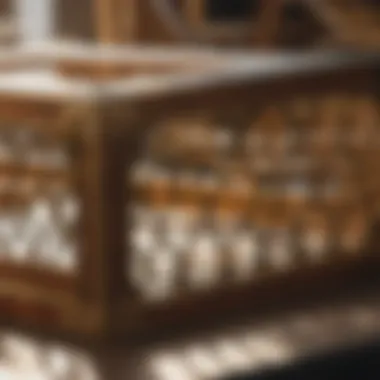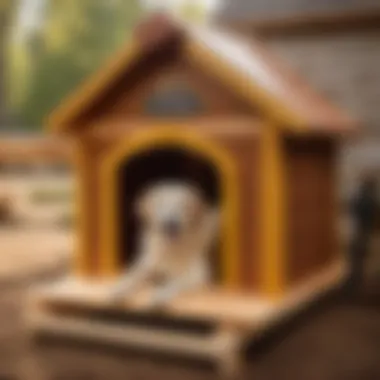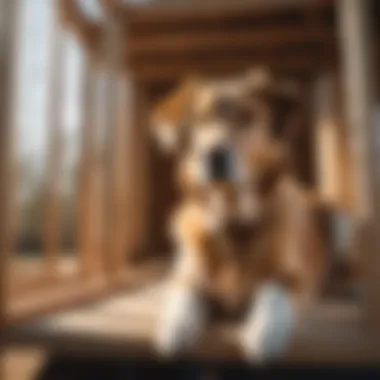Materials:
To embark on the journey of constructing a sturdy dog house frame, gather the following materials with precise measurements:
- Pressure-treated lumber: 10 pieces of 2x4s measuring 8 feet each
- Plywood: 4 sheets measuring 4x8 feet
- Galvanized screws: 1.5-inch and 3-inch
- Waterproof roofing material: 1 roll
- Hinges and latch for the door
- Roofing shingles
- Wood glue
- Waterproof sealant
DIY Steps:
Planning
Before you start building, carefully plan the dimensions of the dog house based on your pet's size and needs. Sketch a design layout to visualize the structure.
Frame Construction
- Cut the 2x4 lumber according to the planned dimensions for the base, walls, and roof rafters.
- Assemble the base frame first, securing the pieces with galvanized screws for stability.
- Build the walls by attaching the 2x4 studs vertically to the base frame and to each other.
Roofing and Finishing
- Construct the roof frame by installing the rafters and securing them at the peak.
- Cover the roof with plywood sheets and affix the waterproof roofing material on top.
- Attach roofing shingles for added protection and aesthetic appeal.
- Install the door with hinges and a latch for easy access.
- Apply a waterproof sealant to all exterior surfaces to enhance durability.
Technical Aspects:
- Tools: Circular saw, drill, hammer, measuring tape, level, paintbrush
- Timing: Allocate a weekend for this project to ensure thorough construction
- Techniques: Ensure precise measurements and angles for a sturdy and professional result
Sequential Steps:
- Begin by cutting the lumber accurately to avoid errors in assembly.
- Follow the planned dimensions closely to ensure the dog house fits together seamlessly.
- Secure all connections with galvanized screws to prevent structural weaknesses.
- Add shingles and roofing materials with precision for effective weatherproofing.
- Seal all joints and corners thoroughly with waterproof sealant to enhance longevity.
Troubleshooting Tips:
- If the walls seem unstable, reinforce connections with additional screws.
- In case of roof leakage, apply more sealant and ensure proper overlapping of roofing materials to prevent water penetration.
Start your dog house construction journey with confidence and meticulous attention to detail, ensuring a safe and cozy shelter for your furry companion!
Understanding the Basics of Dog House Frames


In the elaborate process of constructing a sturdy and reliable dog house frame, it is imperative to grasp the fundamental concepts that underpin the entire structure. Understanding the basics of dog house frames forms the cornerstone of this craft, serving as the blueprint for a successful construction venture. By delving into the essentials, aspiring builders can pave the way for a robust and secure shelter for their beloved pets.
Choosing the Right Materials
Wood Types for Durability
When considering the material options for building a durable dog house frame, wood stands out as a top choice for its inherent strength and longevity. Various types of wood, such as cedar, redwood, or pine, offer durability and resistance to external elements, making them ideal for outdoor use. The key characteristic of these wood types is their natural ability to withstand moisture, rot, and pest infestations, ensuring the longevity of the dog house frame. Utilizing wood types known for their durability not only enhances the structural integrity of the frame but also provides a visually appealing aesthetic that blends seamlessly into outdoor environments.
Considerations for Outdoor Use
In the realm of outdoor dog house construction, considerations for outdoor use play a vital role in determining the longevity and functionality of the structure. Factors such as weather resistance, moisture resilience, and durability under varying climatic conditions are paramount when selecting materials for an outdoor dog house frame. Understanding the unique challenges posed by outdoor exposure enables builders to make informed choices, ensuring that the dog house remains a secure and comfortable refuge for pets throughout different seasons.
Alternative Materials
While wood reigns supreme in the realm of dog house construction, alternative materials offer innovative solutions for builders seeking versatility and modernity in their projects. Materials like plastic, metal, or composite panels present unique characteristics such as lightweight construction, easy maintenance, and customizable features. Despite their advantages, alternative materials may lack the natural aesthetic and traditional charm of wood, requiring builders to weigh the pros and cons carefully based on their specific needs and preferences.
Tools Required


Essential Tools
An essential component of mastering the craft of constructing a sturdy dog house frame is the selection of the right tools for the job. Essential tools such as a hammer, nails, saw, square, and measuring tape are indispensable for accurate and efficient construction. These tools not only aid in precise cutting and assembly of wood pieces but also contribute to the overall structural integrity and quality of the final product. Including essential tools in the construction process ensures that builders have the necessary equipment to execute each step with precision and expertise.
Optional Tools for Precision
For builders who prioritize precision and advanced detailing in their construction projects, optional tools offer additional functionalities that elevate the quality of the final output. Tools like a power drill, orbital sander, router, or nail gun provide efficiency and finesse in cutting, shaping, and fastening components of the dog house frame. While optional tools may enhance the aesthetic appeal and intricacy of the frame, they are not essential for basic construction and can be customized based on individual skill levels and project requirements.
Safety Precautions


Protective Gear
Safety should always take precedence in any construction endeavor, particularly when crafting a dog house frame that involves handling tools and materials. Protective gear such as goggles, gloves, and ear protection shields builders from potential injuries or accidents during the construction process. The key characteristic of wearing protective gear is to minimize risks and ensure a secure working environment that prioritizes the well-being of builders, fostering a safe and efficient construction experience.
Workspace Safety Measures
Creating a safe and organized workspace is crucial for cultivating a productive and hazard-free construction environment. Workspace safety measures, including clearing clutter, securing tools, and maintaining a stable footing, promote cohesion and focus during the construction process. By implementing safety protocols and adhering to best practices in workspace organization, builders can mitigate risks, enhance efficiency, and streamline the construction of the dog house frame, leading to a successful and safe project completion.
Step-by-Step Guide to Building a Dog House Frame
In this article, the 'Step-by-Step Guide to Building a Dog House Frame' section plays a crucial role in providing readers with detailed instructions and insights into the intricate process of constructing a sturdy and secure dog house frame. This section breaks down the construction process into manageable steps, offering a comprehensive roadmap for readers to follow in creating a durable shelter for their beloved canine companions.
Preparing the Blueprint
Design Considerations
Design considerations are pivotal in the construction of a dog house frame as they set the foundation for the entire project. By meticulously planning the design, including factors such as size, style, and layout, homeowners can ensure the final structure meets both functional and aesthetic requirements. Emphasizing design considerations in this article serves to guide readers in making informed decisions that prioritize the safety and comfort of their pets. The unique feature of thorough design considerations lies in its ability to tailor the dog house frame to specific needs, be it architectural cohesion with the main house or optimal space utilization for the dog.
Measuring and Marking Guidelines
Accurate measurement and marking are essential steps in ensuring precision and quality in the construction process. By outlining detailed guidelines for measuring wood pieces and marking structural components, this article equips readers with the knowledge needed to execute each step with meticulous care. Highlighting the importance of measuring and marking guidelines showcases the commitment to craftsmanship and attention to detail required to build a reliable dog house frame. The advantage of following these guidelines lies in the seamless assembly and alignment of components, ultimately contributing to the structural integrity of the final product.
Cutting and Assembling the Frame
Cutting Wood Pieces
The section on cutting wood pieces delves into the intricacies of selecting the right tools and techniques for efficiently shaping the building blocks of the dog house frame. Understanding the significance of precise cuts and proper dimensions is fundamental to the structural strength and stability of the final product. By elaborating on the key characteristics of different cutting methods and their suitability for various wood types, this article empowers readers to execute this phase with expertise and accuracy. The unique feature of expert guidance on cutting wood pieces lies in promoting safe practices and optimal utilization of resources, ensuring a cost-effective and durable outcome.
Structural Assembly Techniques
Structural assembly techniques form the backbone of the dog house frame, providing the framework on which all other elements rely. By elucidating the key characteristics of robust assembly methods and their advantages in terms of longevity and structural soundness, this article emphasizes the importance of skillful construction practices. Exploring efficient and reliable assembly techniques offers readers insight into best practices for ensuring the stability and resilience of the dog house frame. The unique feature of structural assembly techniques lies in their ability to streamline the building process, fostering confidence in homeowners as they witness their project taking shape with precision and strength.
Adding Reinforcements
Corner Braces Installation
The installation of corner braces is a critical step in fortifying the corners of the dog house frame, preventing structural weaknesses and potential collapses. By detailing the key characteristics of durable corner braces and their benefits in reinforcing joints and distributing weight effectively, this article underscores the significance of stability and safety in the construction process. Highlighting the unique feature of corner braces installation involves discussing various placement strategies and fixation methods to ensure optimal support and longevity of the frame.
Roof Support Enhancements
Enhancing the roof support system contributes significantly to the overall resilience and weatherproofing of the dog house frame. By elucidating the key characteristics of reliable roof support enhancements, such as additional beams or trusses, and their advantages in withstanding environmental stressors, this article safeguards the longevity and durability of the structure. Discussing the unique feature of roof support enhancements involves exploring innovative solutions for boosting the framework's load-bearing capacity and structural integrity, offering readers a comprehensive approach to securing their pet's shelter.
Weatherproofing and Finishing Touches
Waterproofing Methods
Weatherproofing the dog house frame is essential for shielding it from moisture, rot, and other external elements that can compromise its structural integrity. By presenting a range of effective waterproofing methods, such as sealants, paints, or specialized coatings, and highlighting their benefits in prolonging the frame's lifespan, this article emphasizes the importance of protective measures against environmental damage. Detailing the unique feature of waterproofing methods encompasses discussing application techniques and maintenance considerations to ensure long-term efficacy and resilience of the dog house frame.
Painting and Sealing Tips
The final steps of painting and sealing not only serve aesthetic purposes but also function as protective layers that enhance the durability and weather resistance of the dog house frame. By offering expert tips on selecting quality sealants, paints, and application methods, this article guides readers in adding the finishing touches that seal and beautify their construction. Describing the unique feature of painting and sealing tips involves outlining color choices, weather considerations, and maintenance protocols that align with the specific needs and preferences of homeowners, culminating in a personalized and sustainable solution.
Enhancing the Dog House Frame for Comfort and Security
When it comes to crafting a sturdy dog house frame, enhancing its comfort and security is vital for the well-being and protection of your furry friend. By focusing on elements that prioritize comfort and security, you can create a safe and cozy shelter that your dog will appreciate.
Insulation Installation
Choosing Insulation Materials
In considering the insulation materials for your dog house frame, it is crucial to select options that provide adequate warmth and protection against harsh weather conditions. Materials such as foam insulation or insulated panels are popular choices due to their excellent thermal properties. These materials not only offer superior insulation but also help regulate the temperature inside the dog house, keeping your pet comfortable in varying climates.
Installation Techniques
When it comes to installing insulation in your dog house frame, the techniques employed play a significant role in ensuring optimal effectiveness. Proper installation techniques, such as sealing gaps and ensuring complete coverage, are essential for maximizing the insulation's benefits. Additionally, using materials that are easy to install and maintain can simplify the process while ensuring long-lasting insulation performance.
Security Features
Enhancing the security of your dog house frame is paramount to protect your pet from potential threats and intruders. By incorporating reliable security features, you can create a safe environment for your dog to rest and play without worry.
Locking Mechanisms
Integrating robust locking mechanisms into the design of the dog house frame adds an extra layer of security to prevent unauthorized access. Features like padlocks or secure latches can effectively secure the entrance, ensuring your pet's safety within the shelter. These mechanisms provide peace of mind knowing that your dog is protected, especially when unattended.
Predator Deterrents
Predator deterrents are essential components to safeguard your dog against wildlife threats. Installing deterrents such as motion-activated lights or ultrasonic repellers can help deter predators from approaching the dog house. These features create a protective barrier around the shelter, reducing the risk of potential attacks and ensuring your pet's security at all times.
Comfort Additions
Incorporating comfort additions into your dog house frame enhances your pet's overall experience, providing a cozy retreat where they can relax and unwind.
Bedding Options
Selecting the right bedding options for your dog house frame is crucial for ensuring optimal comfort and warmth. Soft and insulating materials like memory foam beds or heated pads can offer a luxurious sleeping area for your pet. Additionally, choosing washable and durable bedding options makes maintenance a breeze while prioritizing your pet's comfort.
Ventilation Considerations
Proper ventilation is key to maintaining a comfortable and healthy environment inside the dog house frame. Good airflow helps prevent moisture buildup and ensures adequate air circulation for your pet. Incorporating features like adjustable vents or windows can enhance ventilation while allowing your dog to enjoy a fresh and breathable living space.
Maintenance Tips for Prolonging the Dog House Frame's Lifespan
Maintaining the structural integrity of your dog house frame is vital for ensuring the safety and comfort of your furry friend. Regular upkeep can help extend the lifespan of the frame, saving you time and money in the long run. By implementing a proactive maintenance schedule, you can address issues before they escalate, ultimately enhancing the longevity of the dog house.
Regular Inspection
Performing regular inspections is the cornerstone of effective maintenance. Checking for wear and tear allows you to identify any weaknesses or damage that may compromise the structure. This proactive approach helps in addressing minor issues before they develop into major concerns, ensuring the durability of the dog house frame.
Checking for Wear and Tear
Inspecting the frame for signs of wear and tear is crucial in maintaining its strength and stability. Look for any cracks, rot, or damage to the wood that could weaken the structure. By identifying and repairing these issues promptly, you can prevent further deterioration and prolong the lifespan of the dog house.
Termite Infestation Prevention
Termites pose a significant threat to wooden structures, including dog houses. Implementing termite prevention measures such as treating the wood with appropriate solutions can safeguard the frame against infestations. By proactively addressing this potential issue, you can ensure the longevity of the dog house frame and protect your investment.
Seasonal Upkeep
Adapting your maintenance routines to seasonal changes is essential for preserving the dog house frame. Climate-specific maintenance and tasks such as gutter cleaning help prepare the structure for varying weather conditions, ensuring its resilience against the elements.
Climate-Specific Maintenance
Different climates present unique challenges to dog house frames. Tailoring your maintenance practices to suit the prevailing weather conditions, such as sealing gaps to prevent drafts in colder climates or providing adequate ventilation in warmer regions, can help enhance the longevity of the structure.
Gutter Cleaning
Regularly cleaning the gutters around the dog house removes debris and prevents water buildup, reducing the risk of water damage to the frame. By incorporating gutter cleaning into your seasonal upkeep routine, you can protect the integrity of the dog house and promote its durability over time.





